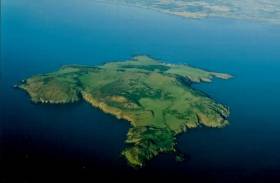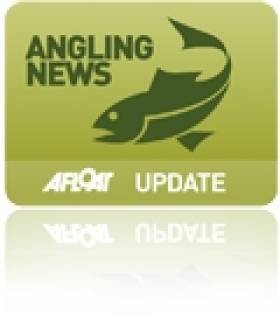Displaying items by tag: Conor Lenihan
#LambayIsland - Conor Lenihan has been revealed as a founding member of a new exclusive club "for the bold and inquisitive" based on Lambay Island, as the Sunday Independent reports.
The Lambay Club, started by members of the family that has owned the island off North Co Dublin for over a century, says it's aimed at protecting Lambay – known for its population of wild wallabies – "with a carefully shaped community of like-minded individuals" who will gather to "imagine, discuss and create".
It's understood that former junior minister Lenihan's role will be to help "shape the club and select the first founder members ... with a strong focus on diversity of age, gender and expertise."
The Sunday Independent has more on the story HERE.
Openings for New Salmon Season Announced
The Minister of State for Natural Resources yesterday announced more details of river openings for fishing in the New Year due to improvement in the salmon stock.
Minister Conor Lenihan announced that 52 rivers across the country - two more than 2010 - would be opened for fishing. A total of 60 will remain closed due to a lack of surplus, which is 20 fewer than last year.
Among those previously closed that will be reopened for 2011 are the Castletown, the Eske, the Glenamoy, the Kerry Blackwater and the Suir. Additional rivers will be opened on a catch-and-release basis.
The River Liffey will have a special one-time opening for fishing on New Year's Day.
Also announced was a €12 reduction in the cost of one-day angling licences, intended to encourage tourist anglers.
The Irish Times has more details on the salmon river openings and closures HERE.
Public Consultation For New Salmon Fishing Rules
MINISTER for Natural Resources Conor Lenihan has opened a 30-day public consultation process on the Wild Salmon and Sea Trout Tagging Scheme Regulations for the 2011 season, The Irish Times reports.
Under the latest draft egulations, 51 rivers out of 141 will open for salmon fishing, with 30 classified as catch-and-release only. Sixty rivers will be closed, which is 20 fewer than the 2010 season, due to "an improvement in salmon stocks".
“Four previously closed, ie Castletown, Suir, Glenamoy and Eske, will open with an identified surplus for harvest,” said the Minister.
Some minor changes have also been recommended "to provide a more effective administration" of the tagging scheme for one-day salmon licences.
Public Consultation on the Wild Salmon and Sea Trout Tagging Scheme Regulations for 2011 Season
The Minister for Natural Resources, Conor Lenihan, has announced the start of a 30 day public consultation process on the Wild Salmon and Sea Trout Tagging Scheme Regulations for the 2011 season.
Regulations are made each year, after public consultation, for the management of the wild salmon and sea trout fishery, based on the scientific and management advice provided to the Minister by Inland Fisheries Ireland.
In launching the public consultation process the Minister remarked,
"The 2011 season will see 20 rivers which were closed in 2010 being opened because of an improvement in salmon stocks. Nineteen rivers will be open to angling on a 'catch & release' basis and 4 rivers which were previously closed, Castletown, Suir, Glenamoy and Eske will open with an identified surplus number of fish for harvest."
In all the Salmon Standing Scientific Committee assessed 141 rivers and have advised that:-
· 51 rivers are open (a surplus of fish has been identified in these rivers) i.e. 1 more than in 2010
· 30 rivers have been classified as open for "Catch and Release" only i.e. 19 more than 2010 (see list below) and
· 60 rivers are closed (no surplus of fish available for harvest) i.e. 20 less than 2010.
With the exception of a proposed change to the number of blue (angling) tags applicable to a one day salmon licence holder, the draft Tagging Scheme Regulations for 2011 are in essence unchanged from the Regulations which were introduced following the establishment of Inland Fisheries Ireland in July, 2010.
A number of minor amendments to the Regulations have also been recommended by Inland Fisheries Ireland, which will provide for more effective administration of the tagging scheme regulations in 2011.
Summary of main changes to the management of the wild salmon fishery in 201120 Rivers which were closed in 2010 will open for angling on a "catch & release" basis in 2011:-
Glyde (Dundalk fishery district)
Slaney (Wexford fishery district) (note; river is closed until 12 May 2011)
Bride (Lismore fishery district)
Glengariff, Adrigole (Cork fishery district)
Kealincha, Lough Fada, Blackwater, Behy, Owenascaul, Milltown, Feohanagh
(Kerry fishery district)
Grange (Sligo fishery district)
Oily, Owenwee (yellow river) (Ballyshannon fishery district|)
Bracky, Glenna, Tullaghobegley, Ray, Glenagannon (Letterkenny fishery district).
4 Rivers which were "catch & release" in 2010 and will open for harvest in 2011 Castletown (Dundalk fishery district)
Suir (Waterford fishery district)
Glenamoy (Bangor fishery district)
Eske (Ballyshannon fishery district).
3 Rivers which were open in 2010 will be limited to "catch & release" in 2011
Sheen (Kerry fishery district)
Screebe (Connemara fishery district)
Srahmore (Bangor fishery district).
The Minister is giving statutory notice of his intention to make the Wild Salmon and Sea Trout Tagging Scheme (No. 2) Regulations, 2010 to provide for the management of the wild salmon and sea trout fishery by Inland Fisheries Ireland in 2011 following the 30 day public consultation.
Any person may submit objections to the draft regulations at any time during the period of 30 days commencing on 20 November 2010 either in writing to the Department or by e-mail to [email protected]
Details of the conservation proposals for 2011 and the draft regulations are available on the Department's website http://www.dcenr.gov.ie/Natural/Inland+Fisheries+Division/Consultation+Process+Wild+Salmon+and+Sea+Trout+Tagging+Scheme+Regulations+for+2011+fishing+season.htm
Irish Atlantic Promoted for Petroleum Exploration
In Dublin this morning, Minister for Natural Resources Conor Lenihan opened an important research conference for the petroleum industry. The Atlantic Ireland 2010 conference brings together researchers and industry alike, to examine the opportunities for oil and gas exploration in the Irish Atlantic.
In his opening address, the Minister outlined to industry representatives the extensive research that has taken place as part of the new exploration regime, involving collaboration between researchers in Ireland and Canada alike.
Earlier this year, he announced his intention to open all basins in the Irish Atlantic margin with proven petroleum prospectivity for petroleum prospecting in the 2011 Atlantic Licensing Round. The Round will close for applications at the end of May 2011.
He said, "This Round is Ireland's largest licensing round to date, covering an area of just over a quarter of a million square kilometres
In-depth, comprehensive research is essential if we are to attract exploration companies to Ireland. Potential investors need to be aware of any geological challenges or indeed opportunities that may exist, before they consider drilling in deep water conditions.
It is because of this research that we know for example, there are a number of large sedimentary basins with proven petroleum prospectivity within the Atlantic margin. This is the kind of work that will be crucial as we seek to exploit our vast ocean resources in the years ahead.
The timing for this important gathering of national and international oil company executives here in Dublin is opportune. It comes immediately after my visit to Singapore last week where I was able to place centre-stage Ireland's offshore exploration potential. There I drove home the message to a large global audience that Ireland's offshore is open for business."
It is hoped that the Conference will further develop new and existing links between Irish universities and international oil companies – Irish researchers provide project mentorship for some of the companies seeking to invest in Irish waters. These relationships will be an important part of attracting investors in the new Licensing Round
Government to Showcase New Exploration Opportunities in Irish Waters
Minister for Natural Resources, Conor Lenihan will next week front a major promotion of Ireland's oil and gas exploration potential to a large global audience. Minister Lenihan will showcase new exploration opportunities in Irish waters – the 2011 Atlantic Margin Licensing Round – at a major international petroleum conference in Singapore.
Ireland's offshore exploration potential will take centre stage at the Oil and Gas Investment Asia conference where Minister Lenihan will deliver a keynote speech, in which he will declare Ireland's offshore open for business.
Speaking prior to this departure for Singapore, Minister Lenihan remarked
"this conference and associated meetings and briefings represent an excellent opportunity to promote Ireland's offshore as a world class exploration destination.
Although we already have two large Asian exploration companies active in Ireland's offshore, we can not expect Asian companies to be fully aware of Ireland's potential.
I will deliver a strong message that as well as our offshore having lots of exploration potential, Ireland is a politically stable economy, with a competitive tax regime, in which their business will be welcome and encouraged to flourish."
Across the three day event Minister Lenihan and his officials will brief senior executives from the largest Asian oil companies about prospects in the Irish offshore. These include Petronas and STX as well as the National Oil corporations of Singapore, the Philippines and Korea. The Minister's itinerary will also include Enterprise Ireland meetings connected with Minister Lenihan's brief as Minister for Science, Technology and Innovation.
Minister Lenihan will particularly stress the opportunities presented by Ireland's latest offshore licensing round – the 2011 Atlantic Margin Licensing Round.
"This round will be Ireland's largest licensing round to date, covering an area of just over a quarter of a million square kilometres" he said.
"It's exciting because we know that within this Atlantic Margin area there are a number of large sedimentary basins with proven petroleum prospectivity. The fact that there are currently 27 companies involved in the offshore petroleum industry in Ireland, including many international companies and some of the world's majors is positive, but Ireland needs to attract a higher level of exploration investment if the petroleum potential of our offshore territory is to be realised. The objective of the 2011 Licensing Round is to attract a greater share of mobile international exploration investment to Ireland.
Now is the time to deliver this message on the world stage – we will do so next week in Singapore," he concluded.

































































